Facts and data on pictograms

Synonyms / Other Terms Used
Baby Care, Baby Care Facilities, Baby Changing Facilities, Change Table
Category
Public Facilities, Services, Hygiene, Travel, Tourism
Message / Function
To indicate the location of baby care facilities
| Source | Description | |
|---|---|---|
 |
ISO 7001 | Side view of figure bending over baby on flat surface, baby feeding bottle in outline |
 |
EJP | Side view of figure bending over baby on flat surface, baby feeding bottle in outline |
 1) 1) |
ÖNORM A 3011 | Side view of female figure bending over baby on flat surface, baby feeding bottle in outline |
 2) 2) |
ON Testdesign | Side view of female figure bending over baby on flat surface |
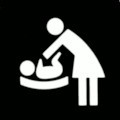 |
KFAI | Side view of female figure bending over baby on curved surface |
| Handbuch wien.gv.at | Side view of human figure in outline, bending over baby on flat surface | |
 |
BS 8501:2002 | Side view of figure bending over baby with diapers on flat surface |
 |
Parks Canada | Side view of figure bending over baby with diapers on flat surface |
 3) 3) |
UIC 413 | Side view of human figure bending over baby with diapers on flat surface |
 |
Pierce | Vertical line, side view of figure bending over baby on flat surface |
 |
ADCA | Human figure with flared skirt holding baby, child on the right |
 |
ULOU | Baby in hooded baby blanket |
 |
FS | Baby with diapers in plan view |
 |
Swiss Post | Small child with opened diapers |
 |
Erco | Small child with opened diapers |
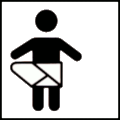 |
DB | Small child with opened diapers |
 |
DTM Berlin | Baby with diapers in plan view |
 |
SIS | Baby with diapers, arms streched out, in plan view |
 |
AIGA | Baby with diapers in plan view |
 |
Eco-Mo Foundation |
Baby with diapers in plan view |
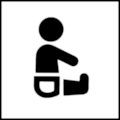 |
BTA 1989 | Side view of baby with diapers |
 |
SNCF | Side view of baby with diapers on baby nursing table |
 |
CNIS | Feeding bottle with measuring scale, baby with diapers |
 |
D/FW | Baby feeding bottle with measuring scale |
 |
FA | Baby feeding bottle in outline, with measuring scale |
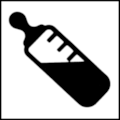 |
BAA | Tilted baby feeding bottle with measuring scale and formula |
 |
Picto'grafics | Tilted baby feeding bottle with formula |
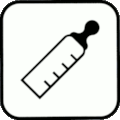 |
ADV | Tilted baby feeding bottle with measuring scale in outline |
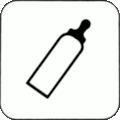 |
ATA | Tilted baby feeding bottle in outline |
Note: Some of the examples shown above were mirrored horizontally to contrast differences.
Discussion
The set of graphic symbols above already implies that no single visual stereotype exists to indicate the location of baby care facilities. Three types of image contents are dominating, and almost all other designs are combinations of these:
In two studies sponsored by the Austrian Railways and the Austrian Standards Institute (Brugger, 1995 a and 1995 b) nine pictogram variants of the table above were examined using the Comprehensibility Estimation procedure. In these tests conducted in Austria, a human figure bending over baby on a baby nursing table always was judged as most suitable with scores above 80, followed by the pictogram from France (SNCF) showing a side view of baby with diapers on a baby nursing table. While scores for pictograms displaying just a baby with diapers in plan view were in a range of 40 to 60, baby feeding bottles were rated as rather incomprehensable with mean and median estimation values below 30.
When tested for comprehension pictograms showing a side view of a figure bending over a baby received more correct responses if a baby feeding bottle also was part of the design (Brugger, 1979). A variant similar to the ÖNORM A 3011 version, but without the baby feeding bottle (marked with 2) and labeled as ON Testdesign), elicited more than 10 % responses related to cooking! In a Comprehension Test 17 years later (Brugger, 1996) two variants were compared, the ÖNORM A 3011 version without the baby feeding bottle labeled 2) and a version similar to the pictogram labeled UIC (3)): both variants reached excellent comprehension scores around 90, much better than in 1979. But there still seems to be room for improvements concerning most variants showing a baby, as the proportions between head and body of the babies displayed often are not correct. In any case, the figure of the grown up should be neutral and not show a female.
In a later Japanese study to propose domestically unified graphical symbols based on scientific methods, the pictogram variant labeled as Eco-Mo Foundation proved to be sufficiently comprehensable with a comprehension score of 80.8 (Eco-Mo Foundation, 2001), therefore exceeding previous comprehensiblity estimates.
Comparing the pictogram showing a baby in a hooded baby blanket with the image of a tilted baby feeding bottle with formula, 63 % of the respondents found the first to be more effective at communicating nursery than the latter (Woodrow, 2016).
Recommendation
Based on the test results available we recommend using a pictogram showing a side view of a human figure bending over a baby on a baby nursing table.
Tests of pictograms of referent Nursery
Brugger, Ch. (1979): Abschlußbericht über den Erkennungstest. Report to the Austrian Standards Institute (ON) dated 12/79, Vienna.
Brugger: Ch. (1995): ÖBB / ON Testserie 1995, Teil 1 Verständnisschätzungen nach ISO 9186. Report to ÖBB GD 02 (Austrian Railways) dated January 1995, Vienna.
Brugger: Ch. (1995): ÖBB / ON Testserie 1995, Teil 2 Verständnisschätzungen nach ISO 9186. Report to ÖBB GD 02 (Austrian Railways) dated February 1995, Vienna.
Brugger: Ch. (1996): Verständnistest UIC Kodex Merkblatt 413. Report to ÖBB GD 02 (Austrian Railways), Vienna, March 1996.
Eco-Mo Foundation (2001): Test data of public information symbols in Japan - Procedure for the testing of public information symbols by the Study Committee. ISO: ISO/TC 145/SC 1 N 329.
Woodrow J.A. (2016): Universal Language of Understanding—Universal Health Care Symbols. Available online: http://openresearch.ocadu.ca/id/eprint/555/1/Woodrow_Jeffery_2016_MDES_INCD_MRP.pdf
Updated 2023-10-17 by Ch.Brugger